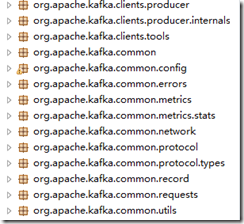1 背景
最近由于项目需要,需要使用kafka的producer。但是对于c++,kafka官方并没有很好的支持。
在kafka官网上可以找到0.8.x的客户端。可以使用的客户端有C版本客户端,此客户端虽然目前看来还较为活跃,但是代码问题还是较多的,而且对于c++的支持并不是很好。
还有c++版本,虽然该客户端是按照c++的思路设计,但是最近更新时间为2013年12月19日,已经很久没有更新了。
从官方了解到,kafka作者对于现有的producer和consumer的设计是不太满意的。他们打算在kafka 0.9版本里发布新的producer与consumer。
其中新的producer已经被包含到了kafka0.8.1的源码里,官方描述如下。
We are working on a replacement for our existing producer. The code is available in trunk now and can be considered beta quality. Below is the configuration for the new producer
现在新producer还是属于beta版。但是在kafka0.9版本里,新producer与consumer都会成为稳定版,并提供了更多的功能。旧版的producer是由scala实现,为java提供调用api。而新版的producer直接是用java实现的。
具体文档在这https://cwiki.apache.org/confluence/display/KAFKA/Client+Rewrite
2 producer基本类的介绍
源码树如下
其中,org.apache.kafka.clients.tools包下的ProducerPerformance.java里包含了producer的最基本用法。
该程序原本是有三个参数的,直接给三个参数硬编码赋值后,代码如下:
public static void main(String[] args) throws Exception { String url = "10.134.58.155:9092"; int numRecords = 100; int recordSize = 100; Properties props = new Properties(); props.setProperty(ProducerConfig.REQUIRED_ACKS_CONFIG, "1"); props.setProperty(ProducerConfig.BROKER_LIST_CONFIG, url); props.setProperty(ProducerConfig.METADATA_FETCH_TIMEOUT_CONFIG, Integer.toString(5 * 1000)); props.setProperty(ProducerConfig.REQUEST_TIMEOUT_CONFIG, Integer.toString(Integer.MAX_VALUE)); KafkaProducer producer = new KafkaProducer(props); Callback callback = new Callback() { public void onCompletion(RecordMetadata metadata, Exception e) { if (e != null) e.printStackTrace(); } }; byte[] payload = new byte[recordSize]; Arrays.fill(payload, (byte) 1); ProducerRecord record = new ProducerRecord("test6", payload); long start = System.currentTimeMillis(); long maxLatency = -1L; long totalLatency = 0; int reportingInterval = 1; for (int i = 0; i < numRecords; i++) { long sendStart = System.currentTimeMillis(); producer.send(record, callback); long sendEllapsed = System.currentTimeMillis() - sendStart; maxLatency = Math.max(maxLatency, sendEllapsed); totalLatency += sendEllapsed; if (i % reportingInterval == 0) { System.out.printf("%d max latency = %d ms, avg latency = %.5f ", i, maxLatency, (totalLatency / (double) reportingInterval)); totalLatency = 0L; maxLatency = -1L; } } long ellapsed = System.currentTimeMillis() - start; double msgsSec = 1000.0 * numRecords / (double) ellapsed; double mbSec = msgsSec * (recordSize + Records.LOG_OVERHEAD) / (1024.0 * 1024.0); System.out.printf("%d records sent in %d ms ms. %.2f records per second (%.2f mb/sec).", numRecords, ellapsed, msgsSec, mbSec); producer.close(); }
可以看到,运行producer需要三个基本的类ProducerConfig,KafkaProducer,ProducerRecord,另外还有回调函数的类Callback。
ProducerConfig类包含了kafka的各种配置信息,并提供了默认的配置。
ProducerRecord类是向broker发送的消息载体,包括topic,partition,key和value属性。
上面这两个类都很简单。
producer所有操作都包含在KafkaProducer类中。
这个类由Partitioner,Metadata,RecordAccumulator,Sender,Metrics这些类组成。
Partitioner是用来计算一个消息的分片的类。
Metadata顾名思义保存的是kafka集群的元数据,metadata的更新和topic有关。
RecordAccumulator类似于一个队列,所有producer发出的消息都先送到队列中,等待处理。
Sender类使用NIO方式实现了producer消息的发送与接收,sender是一个守护线程,监听读写事件,并
Metrics类,kafka本来是被用于分布式的日志收集与监控的,Metrics类可以注册一些关注的内容,供监控使用。
3源码分析
我们以发送一条消息来分析producer的工作过程。
发送一条消息可以分为异步的两个过程。
入队过程
@Override public Future<RecordMetadata> send(ProducerRecord record, Callback callback) { try { Cluster cluster = metadata.fetch(record.topic(), this.metadataFetchTimeoutMs); int partition = partitioner.partition(record, cluster); ensureValidSize(record.key(), record.value()); TopicPartition tp = new TopicPartition(record.topic(), partition); FutureRecordMetadata future = accumulator.append(tp, record.key(), record.value(), CompressionType.NONE, callback); this.sender.wakeup(); return future; } catch (Exception e) { if (callback != null) callback.onCompletion(null, e); return new FutureFailure(e); } }
该send函数首先根据topic获取集群的基本数据,如果topic不存在,该函数会阻塞,并更新metadata。
接下来获取分区,并将数据写入该TopicPartition下的队列中。
public FutureRecordMetadata append(TopicPartition tp, byte[] key, byte[] value, CompressionType compression, Callback callback) throws InterruptedException { if (closed) throw new IllegalStateException("Cannot send after the producer is closed."); // check if we have an in-progress batch Deque<RecordBatch> dq = dequeFor(tp); synchronized (dq) { RecordBatch batch = dq.peekLast(); if (batch != null) { FutureRecordMetadata future = batch.tryAppend(key, value, compression, callback); if (future != null) return future; } } // we don't have an in-progress record batch try to allocate a new batch int size = Math.max(this.batchSize, Records.LOG_OVERHEAD + Record.recordSize(key, value)); ByteBuffer buffer = free.allocate(size); synchronized (dq) { RecordBatch first = dq.peekLast(); if (first != null) { FutureRecordMetadata future = first.tryAppend(key, value, compression, callback); if (future != null) { // Somebody else found us a batch, return the one we waited for! Hopefully this doesn't happen // often... free.deallocate(buffer); return future; } } RecordBatch batch = new RecordBatch(tp, new MemoryRecords(buffer), time.milliseconds()); FutureRecordMetadata future = Utils.notNull(batch.tryAppend(key, value, compression, callback)); dq.addLast(batch); return future; } }
这个函数上面有一大段关于send函数的用法,简单来说,send函数可以实现简单的阻塞式发送(利用Future.get()方法),以及利用回调函数,实现非阻塞发送。
因为这个是一个向套接字写数据的过程,所以入队之后,立刻调用wakeup函数,唤醒阻塞在读数据的sender上,并发送数据。
出队过程
该过程是由守护线程完成的,守护线程不断循环在run函数上
public int run(long now) { Cluster cluster = metadata.fetch(); // get the list of partitions with data ready to send List<TopicPartition> ready = this.accumulator.ready(now); // prune the list of ready topics to eliminate any that we aren't ready to send yet List<TopicPartition> sendable = processReadyPartitions(cluster, ready, now); // should we update our metadata? List<NetworkSend> sends = new ArrayList<NetworkSend>(sendable.size()); InFlightRequest metadataReq = maybeMetadataRequest(cluster, now); if (metadataReq != null) { sends.add(metadataReq.request); this.inFlightRequests.add(metadataReq); } // create produce requests List<RecordBatch> batches = this.accumulator.drain(sendable, this.maxRequestSize); List<InFlightRequest> requests = collate(cluster, batches); for (int i = 0; i < requests.size(); i++) { InFlightRequest request = requests.get(i); this.inFlightRequests.add(request); sends.add(request.request); } // do the I/O try { this.selector.poll(5L, sends); } catch (IOException e) { e.printStackTrace(); } // handle responses, connections, and disconnections handleSends(this.selector.completedSends()); handleResponses(this.selector.completedReceives(), now); handleDisconnects(this.selector.disconnected()); handleConnects(this.selector.connected()); return ready.size(); }
代码注释很清晰了。。
handleSends实现了入队过程中的future以及回调。
后续的一些对网络协议的封装就不再赘述。下一篇,我会接着分析kafka producer的c客户端librdkafka
第一次写博客或许写的不是很清楚,望大家可以多提提意见,谢谢。
